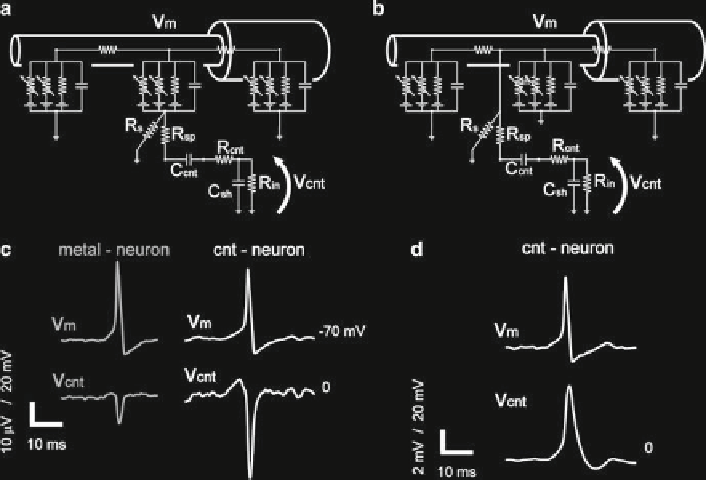Biomedical Engineering Reference
In-Depth Information
Fig. 8
Equivalent circuit models for the CNT neuron. A biophysical mathematical model combin-
ing voltage-dependent cell excitability with the interfacing of the neuronal membrane to CNT-
based electrodes, as implemented in NEURON. Two versions of the same model were defi ned. The
fi rst (
a
) assumes that an extracellular coupling always occurs between the neuronal membrane and
the CNTs, as in metal microelectrodes. As expected, simulations of this model predict a much
larger signal-to-noise ratio, compared to a metal microelectrode (
c
). The second model hypothe-
sized that bundles of CNTs penetrate the lipid double layer and become exposed to the cytosolic
environment (
b
). Under these conditions, the model predicts a response amplitude two orders of
magnitude larger and anticipates a qualitatively different signal shape, intriguingly similar to the
intracellular membrane potential (
d
).
C
cnt
, CNT equivalent capacitance; C
sh
, amplifi er shunt capaci-
tance; R
in
, amplifi er input resistance; R
s
, seal resistance; R
sp
, spread resistance;
R
cnt
, CNT equiva-
lent resistance;
R
s
, seal resistance;
V
cnt
, CNT potential;
V
m
, membrane potential
“spread” resistance. These components describe the ease of ion currents to couple
the extracellular space to the CNT and quantify the electrical shunt to the bulk elec-
trolyte. In Fig.
8a-b
,
R
s
is the sealing resistance between the neuronal membrane
and the surface of the CNT layer, and it accounts for how much the neuronal mem-
brane is in proximity with the CNT electrode. Depending on the size of the electro-
lyte cleft between the neuronal membrane and the nanotubes, this resistance assumes
distinct values, increasing with decreasing distance.
R
s
depends, therefore, only on
the resistivity
r
s
of the electrolyte (i.e.,
r
s
= 70 W cm) and on geometrical parameters
(Fromherz
2002
) ; thus,
=×
is surface overlapping coeffi cient and
d
is
thickness of the electrolyte cleft. Because at a mesoscopic scale the surface of the
CNT substrate appears as a fractal landscape (Fig.
3a
), the thickness
d
of the cleft of
electrolyte and the surface overlapping coeffi cient
R
rd
/,
d
d
seal
s
d
(Grattarola and Martinoia
1993
)

